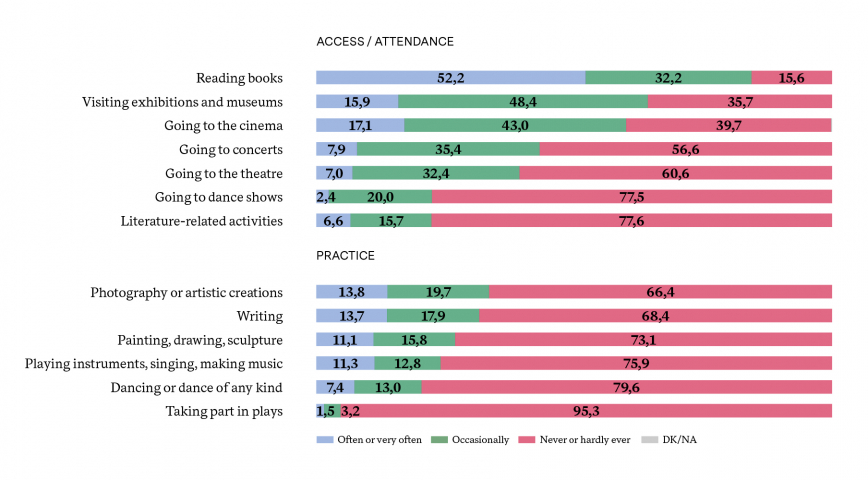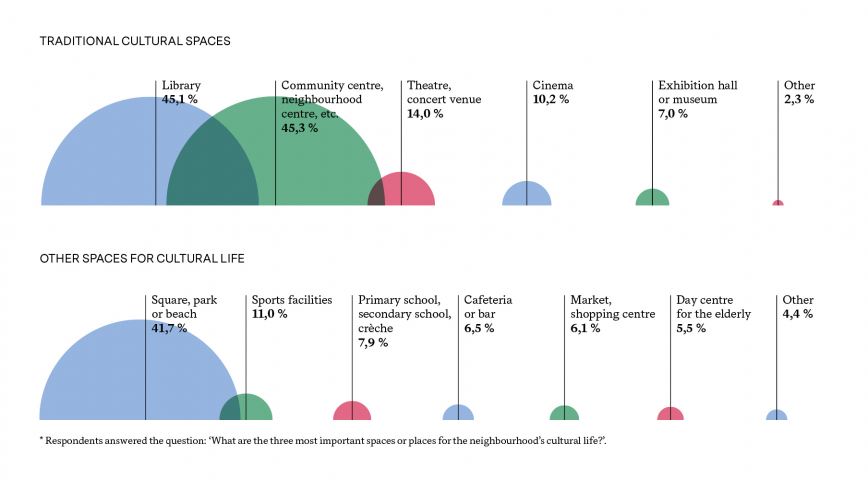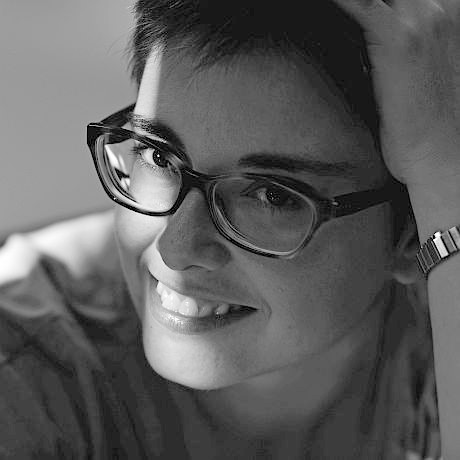Experiencing culture
- Open data
- May 20
- 4 mins

Engaging in cultural life goes beyond attending any of the paying or free activities that the city offers. It is going to shows, visiting exhibitions or reading a book. But it is also about taking part in cultural associations, acting in amateur theatre or painting a picture.
The Barcelona Institute of Culture carried out the ‘Survey on Cultural Participation and Needs in Barcelona’ with the aim of ascertaining the public’s cultural concerns and the value that citizens attach to culture. The findings confirm inequalities in access and in participation, but also show that citizens across the board place a high value on culture.
What is cultural participation like in Barcelona
Citizens engage in culture in many different ways and wide disparities in access to different activities are noted. Reading is the most widespread cultural practice. Only 15.6% claim they never or almost never read books. About one in five people attend dance shows (22.4%) and literature-related activities (22.3%). More than half of the population (62.4%) has access to some sort of cultural activity, and almost one in four people (39.7%) engage in an activity. Only one in ten people actively engage in activities such as photography, writing, painting or playing an instrument.
Cultural participation is not limited to activities under what has been called legitimised culture, but also encompasses other activities that are not necessarily recognised as cultural. Of the respondents, 70.6% participate in these types of activities, almost 10% more than people who access legitimatised activities (62.4%). Walking around the city (70.6%) or walking in nature (43.4%) and going to restaurants (43.5%) are the most common.
% PARTICIPATION IN LEGITIMISED CULTURAL ACTIVITIES

% PARTICIPATION IN NON-LEGITIMISED CULTURAL ACTIVITIES

Factors behind inequality in access
Income and family environment are the main determinants of disparities when it comes to participating in cultural life. Residents of low-income neighbourhoods attend fewer cultural activities and even engage in fewer non-legitimised cultural activities than the average population.
ATTENDANCE OR PRACTICE OF CULTURAL ACTIVITIES (ACCORDING TO THE HOUSEHOLD DISPOSABLE INCOME)

The mother’s engagement in a larger number of cultural activities is also a decisive factor when it comes to accessing culture. When the mother does two or more cultural activities, half of her children declare to practise one, two or more. In contrast, in the case of mothers who do not engage in any activities or just one, 67.2% of their children do not take part in any cultural activity.
PRACTICE OF CULTURAL ACTIVITIES ACCORDING TO MOTHER’S PRACTICE

Cultural needs
Everyone would like to spend more time on cultural activities, both those who already do and those who do not. People with fewer opportunities and resources, that is, those living in low-income neighbourhoods, show a greater need to participate in cultural activities (legitimised and non-legitimised culture). In the case of practice, those who engage in more activities are the ones who would like to do even more. Moreover, access to education in artistic expressions is also influenced by income.
Men and women show similar cultural needs both as regards the attendance and practice of cultural activities. People who undertake fewer activities are the ones who need to do them the most. Specifically, 69.6% of men and 64.5% of women who do not engage in any activity would like to actively participate in one.


% OF PEOPLE WITH TRAINING IN ARTISTIC ACTIVITIES (ACCORDING TO HOUSEHOLD DISPOSABLE INCOME)

Spaces for culture
The highest valued public facilities are libraries and community centres. A significant proportion of the population values as cultural assets spaces that are not necessarily recognised as such, such as squares, parks and beaches (41.7%).
A hypothetical closure of the library or community centre would affect residents of low-income neighbourhoods on a more individual basis. These differences are not noted when asked about how the closure would affect the neighbourhood’s community (and not individuals). Overall, all respondents believe the closure would have a highly significant impact on the neighbourhood’s community (above 8 on a scale of 0 to 10).

IMPORTANT SPACES FOR PEOPLE’S CULTURAL LIFE*

The newsletter
Subscribe to our newsletter to keep up to date with Barcelona Metròpolis' new developments





